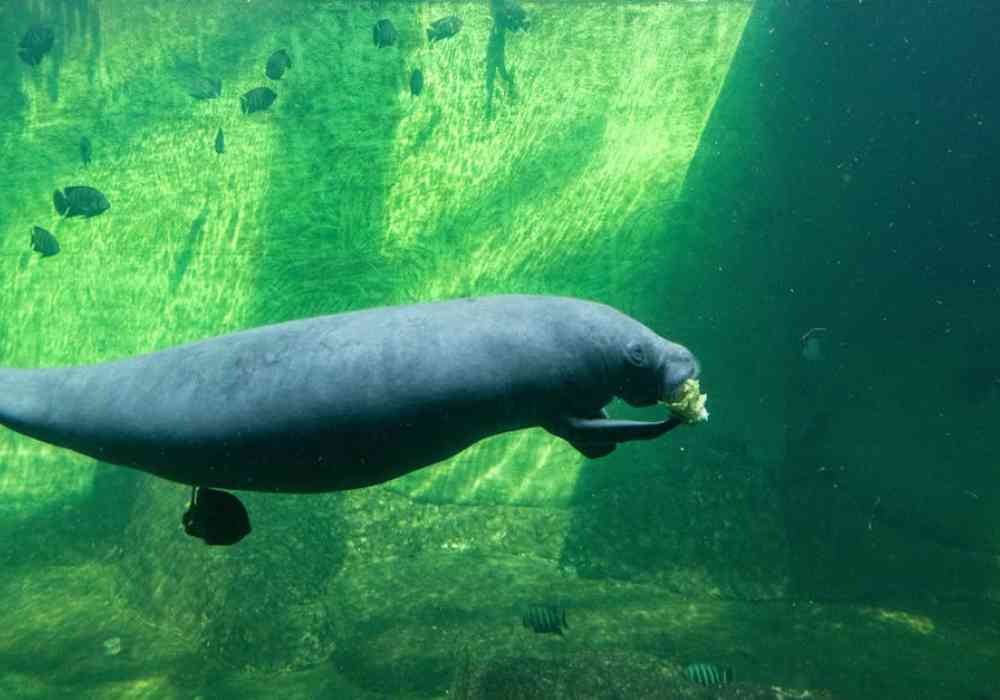The Big Picture: Average Size and Weight of Manatees
How big is the average manatee? The West Indian manatee, a majestic sea creature often affectionately termed a “gentle giant” or “sea cow,” can grow up to 10 feet (3 meters) in length and weigh more than 1,000 pounds (450 kg). These fascinating mammals, with their large size and gentle demeanor, capture the hearts of many, especially in their native waters of Florida.
Manatees are peaceful creatures, leisurely grazing in shallow waters. Their smooth, grey bodies allow them to glide effortlessly through their aquatic habitats. Despite their massive size, they are known for their gentle nature, with no natural predators besides us humans. Unfortunately, they face numerous threats, such as boat collisions and cold water stress, underscoring their vulnerability and need for conservation.
My name is Chris Higgins, a graphic artist based in Key West, Florida, with years of experience observing and illustrating these remarkable creatures. The inspiration for Handshucked Art and Designs comes from the natural beauty of manatees, combined with a passion for unique and handcrafted designs. Let’s explore manatees together, from their impressive size to their vital role in our ecosystem.
How Big is the Average Manatee?
Manatees, often called “sea cows,” are among the largest marine mammals. Their size can be quite impressive! On average, a manatee measures between 9 to 10 feet (2.7 to 3 meters) in length and weighs between 800 to 1,200 pounds (360 to 545 kilograms). However, some particularly large individuals have been recorded at lengths of up to 13 feet (4 meters) and weights as much as 3,500 pounds (1,590 kilograms).
Species Variations
There are three main species of manatees, each with slight differences in size:
- West Indian Manatee (Trichechus manatus): This species is the largest, often exceeding 10 feet in length. It includes the Florida manatee, a subspecies commonly found in the warm waters of Florida.
- Amazonian Manatee (Trichechus inunguis): The smallest of the three, this species inhabits the freshwater rivers and lakes of the Amazon Basin. They typically range from 8 to 10 feet in length.
- West African Manatee (Trichechus senegalensis): Similar in size to the West Indian manatee, they usually measure between 9 to 10 feet and can be found along the west coast of Africa.
Understanding the size and weight variations among these species helps us appreciate their adaptability to different environments. Each species has evolved to thrive in its unique habitat, whether it’s the warm coastal waters of Florida or the freshwater systems of the Amazon.
Despite their size, manatees are incredibly gentle and slow-moving, making them vulnerable to threats like boat collisions. Their sheer size and peaceful nature make them a beloved symbol of marine conservation efforts.
In the next section, we’ll explore the physical characteristics of manatees, shedding light on what makes these gentle giants so unique.
Physical Characteristics of Manatees
Manatees, often referred to as “gentle giants,” have unique physical features that make them well-suited for their aquatic environments.
Appearance and Body Shape
Manatees have a distinctive, rounded body that tapers into a flat, paddle-shaped tail. Their bodies are covered with tough, wrinkled skin, often hosting a layer of algae that gives them a greenish hue. This algae growth is a result of their slow movement and frequent resting at the water’s surface.
Flippers
Manatees possess two front flippers that resemble paddles. These flippers are not only used for steering and balance but also for manipulating food. Manatees use their flippers to bring vegetation to their mouths, showcasing a surprising dexterity for such large animals.
Tail
The manatee’s tail is broad and powerful, resembling a paddle. It propels them gracefully through the water, despite their large size. Unlike dolphins, manatees move their tails up and down to swim, allowing them to steer their shallow habitats efficiently.
Facial Features
Their faces are adorned with whisker-like bristles known as vibrissae, which are sensitive to touch and help them explore their surroundings. Manatees have small eyes and no external ears, but they boast excellent hearing and vision.
These physical characteristics not only define their appearance but also play vital roles in their survival. The manatee’s design is perfectly suited to their slow-paced, aquatic lifestyle, allowing them to thrive in the warm waters they call home.
In the next section, we’ll dive into the habitats and distribution of these fascinating creatures, exploring where they live and how they migrate.
Habitat and Distribution
Manatees are fascinating creatures that thrive in shallow waters. They prefer calm rivers, estuaries, saltwater bays, and coastal areas. These gentle giants are well-adapted to both fresh and saltwater environments, frequently moving between the two without any trouble.
Florida: A Manatee Haven
Florida is a key location for manatees, especially the Florida manatee, a subspecies of the West Indian manatee. The state’s warm waters provide an ideal habitat, particularly during the winter months. Manatees gather in large numbers at natural springs and warm-water effluents from power plants. These warm refuges are crucial for their survival during the colder months.
Migratory Patterns
Manatees are known for their migratory behavior. In the summer, some Florida manatees travel up the eastern coastline of the United States, venturing as far north as Virginia and the Carolinas. In the Gulf of Mexico, they can be found as far west as Texas. Despite these long journeys, they tend to stick close to channels and shorelines, ensuring they remain in familiar territory.
Beyond Florida
Outside of Florida, manatees can be found throughout the Caribbean and along the Gulf of Mexico coast. They are present in countries like Mexico, Belize, and Brazil, although in smaller populations. Historically, manatees inhabited a wider range, but factors like hunting and habitat loss have reduced their numbers in some areas.
In the next section, we’ll explore the size and growth of manatee calves, shedding light on how these creatures develop from birth.
How Big is the Average Manatee at Birth?
When a manatee calf is born, it is already quite large compared to many other newborn animals. At birth, a typical calf measures about 4 to 4.5 feet (1.2 to 1.4 meters) in length and weighs around 60 to 70 pounds (27 to 32 kilograms). That’s about the size of a large dog!
Growth Rate and Development
Manatee calves grow quickly, thanks in part to the rich milk they receive from their mothers. They start nursing within hours of birth, and their mothers continue to nurse them for one to two years. During this time, calves also begin eating plants a few weeks after birth, which helps them grow even more.
The growth rate of a manatee calf is quite impressive. In just a few years, they can reach the size of a subadult, which is significantly larger than their birth size. By the time they are about five years old, they are considered adults and can weigh between 800 to 1,200 pounds (360 to 545 kilograms).
Early Life and Independence
Manatee calves are quite independent from the start. They can swim to the surface on their own shortly after birth. This ability is crucial for their survival, as they need to breathe air just like we do. Calves also vocalize at or soon after birth, which helps them bond with their mothers.
During their early years, calves learn essential skills from their mothers, such as how to find food and steer their watery environment. This period of learning and growth is vital for their development and future independence.
In the next section, we’ll answer some frequently asked questions about manatees, including how big they get as adults and their lifespan.
Frequently Asked Questions about Manatees
How big is a full-grown manatee?
A full-grown manatee is quite a sight to behold! These gentle giants typically measure between 9 to 10 feet (2.7 to 3 meters) in length. In terms of weight, they generally range from 800 to 1,200 pounds (360 to 545 kilograms). That’s about the size of a small car!
What is the biggest manatee ever recorded?
While most manatees fall within the average size range, some exceptional individuals have grown even larger. The biggest manatee ever recorded reached an impressive length of up to 13 feet (4 meters) and weighed as much as 3,500 pounds (1,590 kilograms). These rare giants demonstrate the remarkable potential size of these creatures.
How long do manatees live?
Manatees have a relatively long lifespan compared to many other marine animals. In the wild, they can live for about 40 years, though some have been known to reach up to 60 years. In captivity, where they are protected from threats like boat collisions and environmental changes, manatees may live even longer. This extended lifespan is a testament to their resilience and adaptability in various environments.
Conclusion
At Handshucked Designs, we celebrate the beauty and wonder of manatees through our unique art and designs. Our Hungry Manatee series is just one way we express our admiration for these gentle giants. By incorporating manatees into our artwork, we aim to raise awareness about their plight and the importance of conservation efforts.
Manatees face numerous threats, including habitat loss, boat collisions, and environmental changes. Conservation efforts are crucial to ensuring their survival. Organizations and programs are working tirelessly to protect manatees by preserving their habitats, rescuing injured individuals, and advocating for policies that mitigate human impact.
We believe art can be a powerful tool for change. By sharing the story of manatees through our designs, we hope to inspire others to support conservation initiatives and appreciate these incredible creatures. Together, we can help ensure that manatees continue to thrive in our waters for generations to come.
Check out our Handshucked Designs store to explore our manatee-inspired merchandise and join us in supporting manatee conservation.






